Introduction
The wide angle of view makes the Tokina 11-20mm a useful lens for landscape, architecture, and interiors, as well as for shooting in restricted spaces. Wide-angle lenses can also create some dramatic pictures, as they exaggerate the distance from the near to the far making subjects in the foreground appear very big. This is a popular technique in landscape photography, but can also be used to create striking images of other subjects in portrait or product photography. You need to get very close to the subject in the foreground to emphasis the effect, which has an impact on depth of field, so sharpness at the smaller apertures (such as f/11 to f/22) is important for photographers looking to capture maximum sharpness with a wide-angle lens.
We’ve run the Nikon DX lens mount version of the Tokina 11-20mm though our industry-standard optical test and are delighted to bring you the verified results.
Key specifications:
Max. aperture: f/2.8
Min. aperture: f/22
Angle of view: 104 – 84
Min. focus distance: 1.0ft (0.3m)
Filter size: 77mm
Measurement: Top-ranking DX wide
With an overall DxOMark score of 20 points, the Tokina 11-20mm f/2.8 is the highest-ranked wide-angle zoom for Nikon DX. Scores range from that high of 20 points on the Nikon D5300 to a low of 9 points on the Nikon D40x, and we’ve tested the Tokina 11-20mm f/2.8 on no fewer than 12 Nikon APS-C format DSLRs.
Ranking just ahead of its predecessor, the Tokina 11-16mm f/2.8 with 19 points, the new 11-20mm wins in all lens metrics categories, with the exception of sharpness. For sharpness, the shorter-focal-length Tokina 11-16mm narrowly comes out on top with a score of 12 P-Mpix, compared to 11 P-Mpix for the new Tokina 11-20mm f/2.8.
The sharpness P-Mpix map shows that the Tokina 11-20mm f/2.8 offers excellent center resolution at all focal lengths using wider apertures up to f/8, with respectable sharpness at f/11, too. Diffraction at the smaller apertures of f/16 and f/22 reduces center resolution, as indicated by the orange and red colors, which will impact resolution on long depth-of-field shots.
Further analysis of the Tokina 11-20mm f/2.8’s sharpness field maps identify that the excellent center sharpness at the best-performing apertures doesn’t extend to the corners of the frame, with the outer field resolution dropping a little. For example, at the widest 11mm focal length, center resolution of 70% drops to around 55-60% in the outer field. Zoom in a little to 16mm, however, and uniformity improves, with sharper results in the corners; the strongest overall sharpness is achieved at 16mm f/8 on the Tokina 11-20mm f/2.8.
Rectilinear wide-angle lenses like the Tokina 11-20mm f/2.8 have the advantage of keeping lines reasonably straight, unlike a fisheye lens that significantly distorts lines in an image. Despite this, even rectilinear wides suffer from some barrel distortion, but the Tokina 11-20mm f/2.8 controls the effect extremely well. At its widest 11mm focal length, barrel distortion of almost 1% will require some correction in post-processing, but zoom in to 20mm and the issue is almost completely eradicated, with distortion at just 0.1%.
Another optical flaw associated with wide-angle zoom lenses is chromatic aberration or fringing, which appears as colored lines along contrast edges. A relatively low chromatic aberration score of 18um on the Tokina 11-20mm f/2.8 means that fringing will occur at some settings. As indicated by the red areas on the global map, the problem is at its worst at wider focal lengths between 11-14mm using all aperture settings, but is better controlled between 16mm to 24mm.
Comparison: Tokina 11-20mm f/2.8 vs Nikon 10-24mm f/3.5-4.5 vs Sigma 10-20mm f/3.5
We’ve tested a total of 10 different wide-angle zoom lenses on the Nikon D5300, with scores ranging from a high of 20 points for the new Tokina 11-20mm f/2.8 to a low of 11 points for the Sigma 10-20mm f/4-5.6 EX DC HSM.
The own-brand $897 Nikon 10-24mm f/3.5-4.5G and third-party $449 Sigma 10-20mm f/3.5 EX DC HSM alternatives both offer a greater focal range, but the new Tokina 11-20mm f/2.8 just outscores them in most categories. Boasting the largest maximum aperture of the three, the Tokina 11-20mm f/2.8 offers the best transmission score of 2.9 TStop, as well as slightly better vignetting at 0.9EV and the same score of 0.4% for distortion. Sharpness among the three is also pretty close overall, but the Sigma just shades it, with slightly improved center resolution at the longest focal lengths and widest apertures compared to the Tokina 11-20mm f/2.8.
Conclusion: A versatile wide
A useful lens in restricted space that’s also capable of creating some dramatic images, a wide-angle lens is a great addition to any photographers’ kit bag and a “must have” for landscape and architectural photo enthusiasts. The new Tokina 11-20mm f/2.8’s increase in focal length over its 11-16mm predecessor makes it a more versatile option that puts it more in line with the wide-angle competition from Nikon and Sigma.
Tested on the Nikon D5300, it’s also the highest-ranking DX-format wide-angle we’ve tested to date, with good transmission and well-controlled distortion and vignetting. For sharpness, it’s just out cored by the Sigma 10-20mm, but the Tokina 11-20mm still offers excellent center resolution at focal lengths using the wider apertures up to f/11. Resolution at 16mm using apertures f/8 and f/11 is the strongest — boasting uniform sharpness results for landscape shots — but for maximum depth-of-field shots, resolution at the minimum apertures f/16 and f/22 is just a little softer.


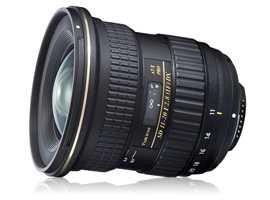





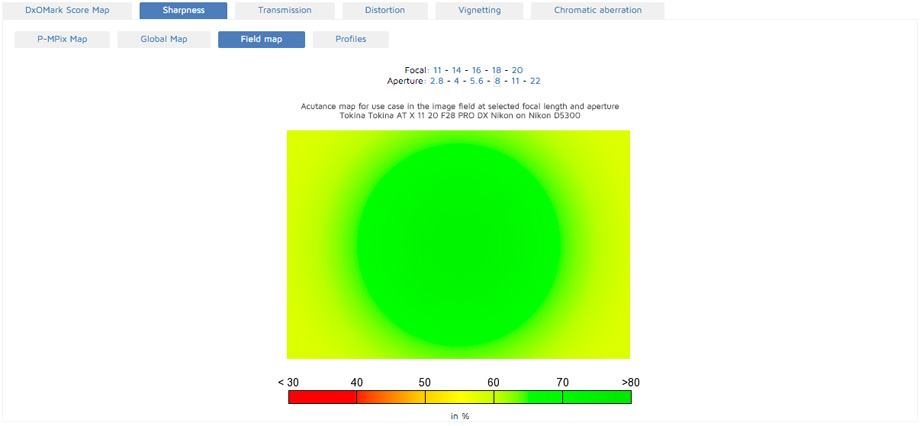
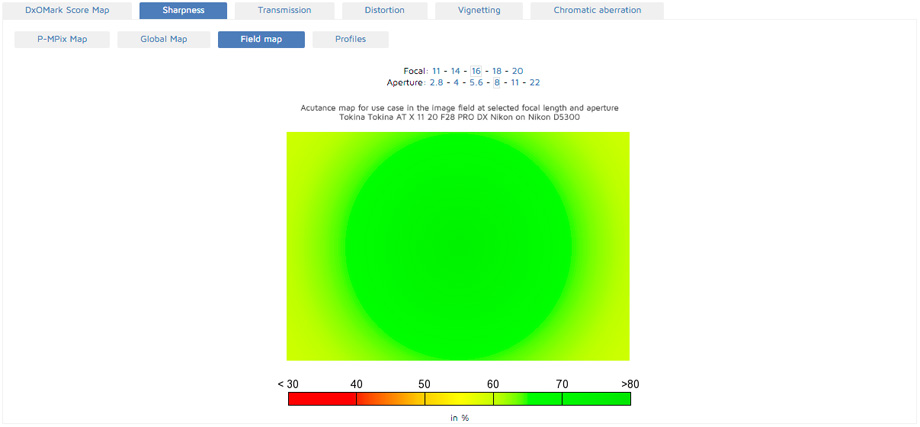
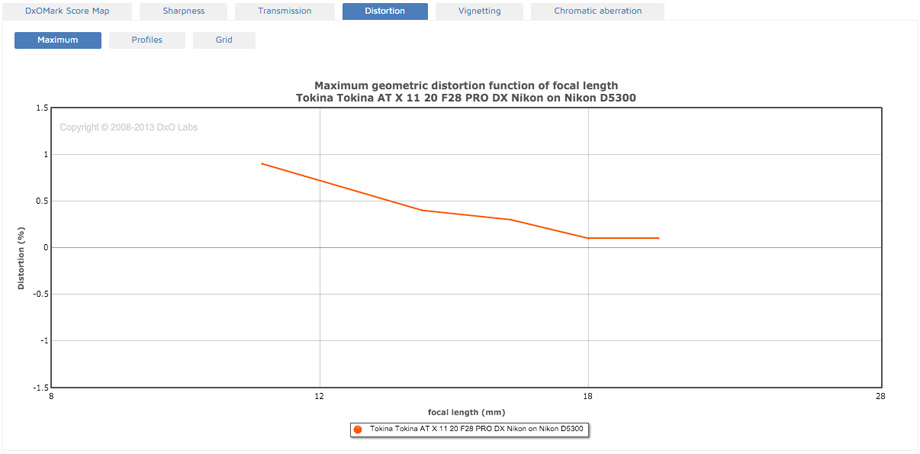
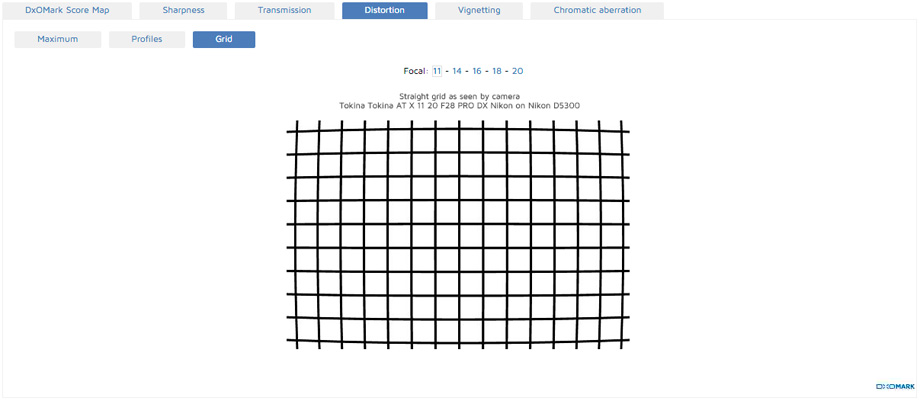

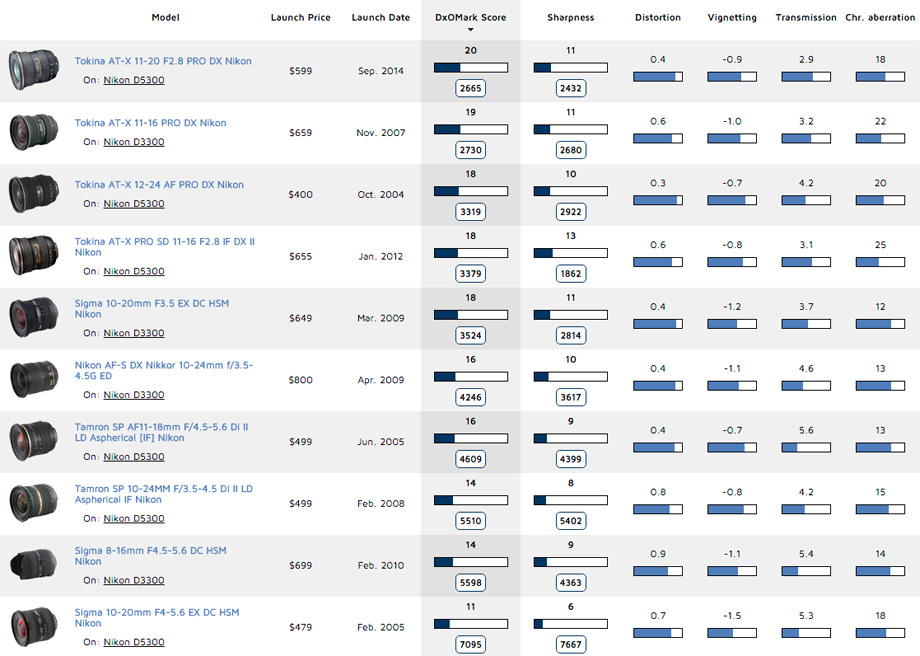
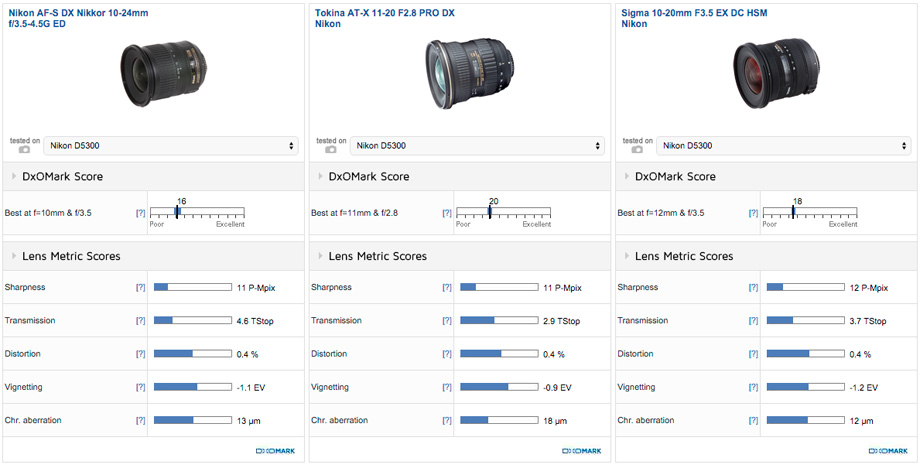
DXOMARK encourages its readers to share comments on the articles. To read or post comments, Disqus cookies are required. Change your Cookies Preferences and read more about our Comment Policy.